Nothing is perfect. The crystalline structures that we have looked at all have imperfections. We will quantify these imperfections here.
Crystalline Defects
A crystalline defect is a lattice irregularity having one or more of its dimensions on the order of an atomic dimension. There are 5 major categories of crystalline defects:
Point defects allow for diffusion to occur in the solid state.
There are different categories of point defects:
Linear Defects (Dislocations)
A line defect is a lattice distortion created about a line formed by the solidification process, plastic deformation, vacancy condensation or atomic mismatch in solid solutions.
Dislocations explain the observation of plastic deformation at lower stress than would be required in a perfect lattice. They also explain the phenomenon of work hardening.
There are different categories of point defects:
The Burgers Vector, b, quantifies the magnitude and direction of the structural defect. It is the displacement vector necessary to close a step-wise loop around the defect. For common metals this is the repeat distance along the highest atomic density direction. Equivalently, the Burgers vector denotes the direction and magnitude of the atomic displacement that occurs when a dislocation moves.
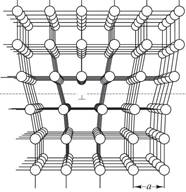
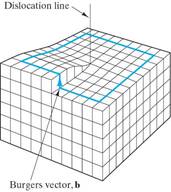
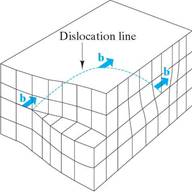
At ambient temperatures, grain boundaries give strength to a material. So in general, fine grained materials are stronger than coarse grained ones because they have more grain boundaries per unit volume. However, at higher temperatures, grain boundaries act to weaken a material due to corrosion and other factors.
Grain size can be quantified by
The size and shape of grains are determined by a number of factors during solidification:
Most materials are polycrystalline (or polygranular). There are some applications where the expense and time to produce single crystal materials (and hence no grain boundaries) is justified:
Volume (Bulk) Defects
These are introduced during processing and fabrication.
Pores
Cracks
Foreign inclusions
Noncrystalline solids
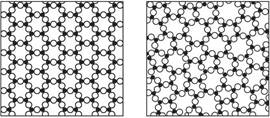
The Zachariasen model is the visual definition of the random network theory of glass structure (which is analogous to the point lattice associated with crystal structure). It is “perfectly” random, although it does have short-range order (SRO) as the building block of the crystal is retained. (e.g. AlO33- triangles)
Synonyms for noncrystalline: amorphous, vitreous, glassy, short-range order
Materials processed to avoid crystallization can have desirable unique props.
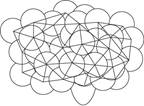 Amorphous Metals (Metallic glasses) have high strengths and corrosion resistance due to lack of grain boundaries (but the process is expensive). The Bernal Model is helpful in visualizing this structure.
Amorphous Metals (Metallic glasses) have high strengths and corrosion resistance due to lack of grain boundaries (but the process is expensive). The Bernal Model is helpful in visualizing this structure.
Amorphous semiconductors – economical (but complex electronic props).
Medium-range order refers to a tendency for some structural order to occur in the medium ranges of a few nanometers. This can occur in common glasses containing significant amounts of modifiers such as Na2O and CaO. For example CaO-SiO2 glass has CaO6 octahedra share edges in a regular arrangement. This is in contrast to the random distribution of Na+ ions in the random network model that describes vitreous SiO2
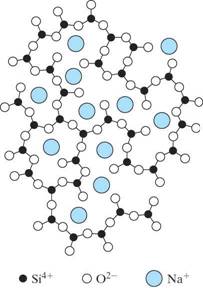
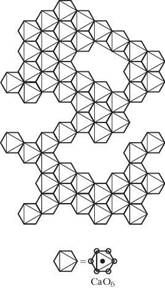
Atomic Vibrations
At any temperature above absolute zero, the atoms in a solid are vibrating very rapidly about their lattice positions. These vibrations are considered to be defects in the material. At room temperature a typical vibration frequency is 1013 vibrations/sec and the amplitude is 0.003 nm.
Temperature is a measure of the average vibrational energy of the atoms in a material. In other words, an average energy, Eave, is associated with the atoms in a material at any given temperature. The higher the temperature, the higher is this average energy.
However, not all of the atoms have the average energy associated with the given temperature. Some will have an energy that is lower; others will have an energy that is higher. There will be a statistical distribution of the energies of all the atoms about the average energy for that temperature. Furthermore, an individual atom’s vibrational energy will vary randomly with time.
The percentage of atoms with energies above the average for a given temperature can be found with the Maxwell-Boltzmann distribution:
P µ e - (E* - Eave) / kT
P is the probability of finding an atom with energy E*. (E* is above Eave, the average energy characteristic of a particular temperature.)
For a given E*, the probability of finding atoms with that energy will increase as the temperature increases. And of course for a given temperature, the probability of finding an atom with energy E* will be high if E* is close to Eave.
Source: https://fog.ccsf.edu/~wkaufmyn/ENGN45/Course%20Handouts/Chap04_Imperfection%20in%20Solids.doc
Web site to visit: https://fog.ccsf.edu/
Author of the text: indicated on the source document of the above text
If you are the author of the text above and you not agree to share your knowledge for teaching, research, scholarship (for fair use as indicated in the United States copyrigh low) please send us an e-mail and we will remove your text quickly. Fair use is a limitation and exception to the exclusive right granted by copyright law to the author of a creative work. In United States copyright law, fair use is a doctrine that permits limited use of copyrighted material without acquiring permission from the rights holders. Examples of fair use include commentary, search engines, criticism, news reporting, research, teaching, library archiving and scholarship. It provides for the legal, unlicensed citation or incorporation of copyrighted material in another author's work under a four-factor balancing test. (source: http://en.wikipedia.org/wiki/Fair_use)
The information of medicine and health contained in the site are of a general nature and purpose which is purely informative and for this reason may not replace in any case, the council of a doctor or a qualified entity legally to the profession.
The texts are the property of their respective authors and we thank them for giving us the opportunity to share for free to students, teachers and users of the Web their texts will used only for illustrative educational and scientific purposes only.
All the information in our site are given for nonprofit educational purposes